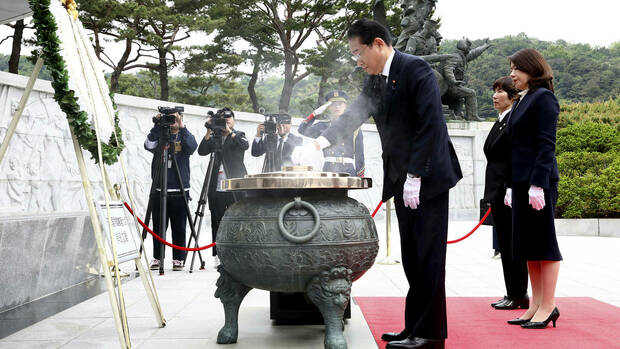Japan’s Prime Minister Fumio Kishida lights incense sticks at Korea’s national cemetery during his visit to South Korea.
(Photo: IMAGO/Kyodo News)
Tokyo After a twelve-year break, diplomacy between the quarreling US allies South Korea and Japan is getting going again. On Sunday, Japanese Prime Minister Fumio Kishida met South Korean President Yoon Suk Yeol in Seoul for the second bilateral summit in two months. And the third follows at the meeting of the seven traditionally industrialized nations (G7) in Hiroshima, which will take place next week.
In their home country of Kishida, they will deepen what they discussed on Sunday in South Korea’s capital: security issues such as North Korea’s nuclear program and China’s growing power in the region, as well as closer cooperation in the chip industry. South Korea is one of the most important suppliers of chips to the world, but also to China.
“We are at a historical turning point,” said South Korean President Yoon, explaining the sudden flare-up of lively summit diplomacy. Kishida agreed: “The regional security situation is very difficult,” said the Japanese. Close relationships with one another and with our common ally, the USA, are therefore “very important”.
Countries must act together against attempts to “change the status quo by force,” Kishida said. This formulation has become common in diplomacy as a reference to China when politicians do not want to mention China by name. Because China does not only claim islands controlled by Japan. The Middle Kingdom is also threatening to unite Taiwan with the People’s Republic by force if necessary. South Korea and Japan also see North Korea’s nuclear program as a threat to their immediate neighbourhood.
The sense of threat from Beijing and Pyongyang has become so great, especially among South Korea’s conservatives, that President Yoon has begun to remove critical blockades to better relations with Japan since taking office a year ago.
>> Read here: Attacks in Japan – How stable is the country?
The conflicts surrounding the historical interpretation of Japan’s annexation of Korea in the first half of the 20th century are usually extremely emotionally charged.
The legal dispute over compensation for Korean forced laborers employed by Japanese companies during World War II almost completely froze diplomatic relations. South Korean courts granted those affected the right to compensation. When the companies failed to pay, orders followed to confiscate the defendants’ assets to pay the plaintiffs.
However, the Japanese government saw this as a violation of the basic bilateral treaty of 1965, which from the Japanese point of view has solved all questions of compensation. The problem: Many Koreans consider this contract to be unfair.
Close cooperation, but tensions remain
As a compromise, Yoon has pushed through a company-financed fund from which the plaintiffs are now to be compensated. In doing so, he created the precondition for the first summit with Kishida in March. Since then, the two governments have begun to work together again across the board and resolve some critical issues.
In addition to military maneuvers with the United States, this includes close discussions on security issues, including the United States’ nuclear shield. Japan, in turn, retaliated by, among other things, facilitating the export of important chemicals for semiconductors, which had been exacerbated in the compensation dispute.
Yoon and Kishida also agreed on Sunday to strengthen cooperation between the strong Korean chip industry and the important Japanese suppliers of production equipment and chemicals.
>> Read here: Between rapprochement and deterrence – the contradictory China course of the USA
Kishida even gave in to an explosive Korean demand: Japan’s government wants to discharge more than a million tons of radioactive isotope-free cooling water from the nuclear ruins in Fukushima into the ocean in a controlled manner, which, however, is still contaminated with toxic tritium. Kishida has now invited South Korean experts to examine the plan independently of the International Atomic Energy Agency.
Japan’s head of government even went into the colonial history of his country, without apologizing. “I myself am heartbroken that so many people have suffered so much pain and sadness in the difficult circumstances of this time,” Kishida said.
Yoon stressed that both sides should focus on the future. The open question is whether this will be enough to convince South Korea’s public, which is wary of Japan’s conservatives. Because in Kishida’s Liberal Democratic Party, many politicians want to glorify the dark sides of Japanese history.
More: This handshake could make history
